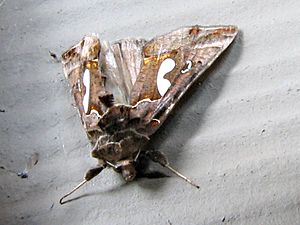Megalographa biloba facts for kids
Quick facts for kids Megalographa biloba |
|
|---|---|
 |
|
 |
|
| Scientific classification | |
| Kingdom: | |
| Phylum: | |
| Subphylum: | |
| Class: | |
| Order: | |
| Family: | |
| Genus: |
Megalographa
|
| Species: |
M. biloba
|
| Binomial name | |
| Megalographa biloba (Stephens, 1830)
|
|
| Synonyms | |
|
|
Meet the Stephens' gem or bilobed looper moth! Its scientific name is Megalographa biloba. This amazing moth belongs to the Noctuidae family, which includes many types of owlet moths.
This moth is known for its wide travels. It lives in the southern United States, all the way through Central America, and down to Argentina in South America.
Contents
About the Bilobed Looper Moth
The bilobed looper moth is a medium-sized moth. Its wingspan is about 38 to 44 millimeters. That's about the length of two small paperclips!
Where These Moths Live
These moths are found in many places. They live in the southern parts of the United States. You can also find them in Central America and South America. They even fly as far south as Argentina.
Amazing Moth Migrations
The bilobed looper moth is a seasonal migrant. This means it travels long distances depending on the season. During warmer months, it flies north. You can find it in the northern parts of the United States and even southern Canada.
These moths usually have one or two groups of babies (generations) each summer in the north. However, it is very rare for them to survive the cold winter there. They often fly back south or die off when it gets cold.
Moths in New Places
This moth has also been seen in the Hawaiian Islands. Scientists are not sure if it naturally lives there. It might have arrived on its own or been brought there by people.
It has also been recorded in Great Britain. This is very unusual! It might be a rare visitor that flew across the Atlantic Ocean. Or, it could have traveled there by accident on ships.
What the Moth Eats
Sometimes, the bilobed looper moth is considered a minor problem for farmers. This is because its caterpillars can feed on cultivated lettuce plants. They might munch on the leaves, which can damage the crop.

